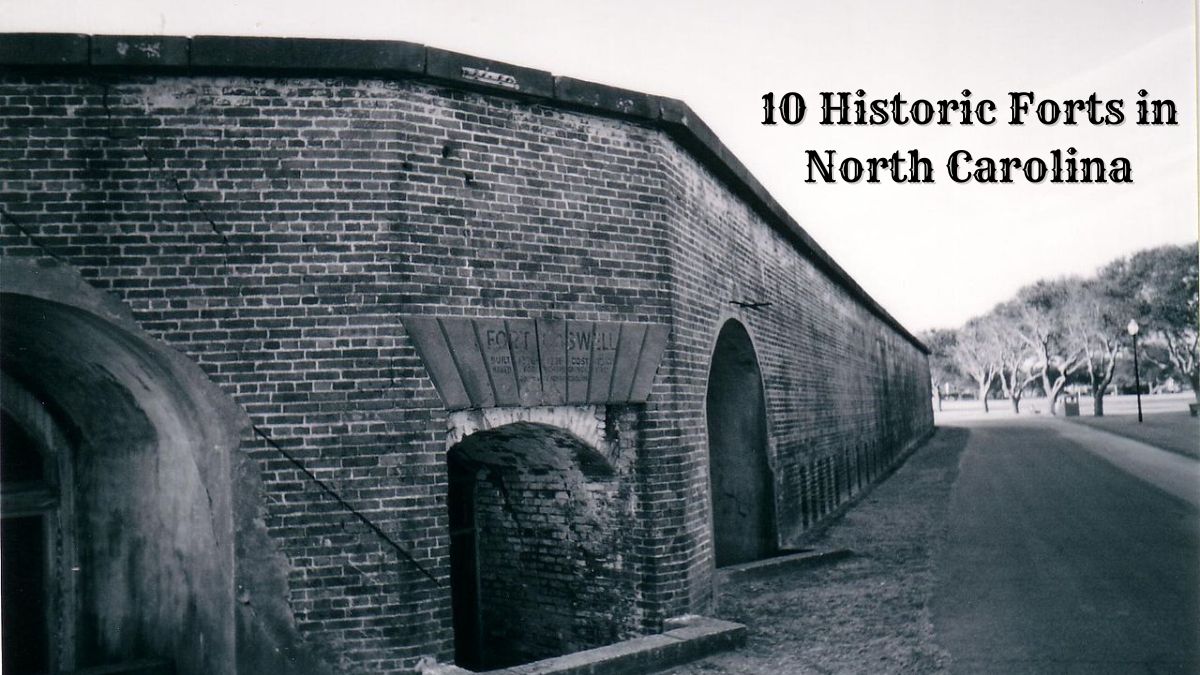Bathed in the amber hues of countless sunsets, the historic forts of North Carolina stand as silent witnesses to a bygone era. Their weathered ramparts and moss-laden stones tell tales of courage, sacrifice, and the ceaseless march of time.
In “Historic Forts in North Carolina,” we embark on a journey through the corridors of the past, rediscovering these majestic guardians of history that have quietly shaped the very fabric of the Tar Heel State.
Join us as we unravel the mysteries and chronicles of these unsung sentinels, relics of a time when they stood on the frontlines, shaping the destiny of a burgeoning nation.
Historic Forts in North Carolina
| 1. Fort Caswell (1836-1945) | 6. Fort Branch (1862) |
| 2. Fort Fisher (1861-1865) | 7. Fort Anderson (1861) |
| 3. Fort Raleigh | 8. Fort Macon (1826) |
| 4. Fort Holmes (1863-1865) | 9. Fort Johnston (1748-1881) |
| 5. Fort Campbell (1862-1865) | 10. Fort Dobbs (1756) |
1. Fort Caswell (1836-1945)

Situated on Oak Island, close to the mouth of the mighty Cape Fear River, is Fort Caswell, a historic monument whose foundations are steeped in tales of warfare, faith, and resilience.
The fort’s geographical significance is undeniable, with the Atlantic Ocean stretching out on one side and the winding river on the other. It has been pivotal in several phases of North Carolina’s history.
A Civil War Bastion: The Confederate Hold (1861-1865)
Fort Caswell’s military importance can be traced back to the Civil War era. Due to its strategic location by the Atlantic Ocean, the fort played an instrumental role in safeguarding the Port of Wilmington—one of the Confederacy’s most crucial ports.
In the early days of the war, around 1861, Confederate forces realized the immense strategic value of Fort Caswell and promptly occupied it.
Under the guidance of senior officers and key figures like General W.H.C. Whiting, the fort was transformed into a formidable stronghold. Throughout the war, Fort Caswell resisted multiple attempts by Union forces to breach its walls, ensuring that the Port of Wilmington remained a lifeline for the Confederate states.
However, as the Civil War progressed and Union forces tightened their grip on the South, the fort faced increasing threats. By 1865, realizing the mounting pressure and the potential loss of the fort, Confederate forces evacuated Fort Caswell, strategically detonating its main gunpowder magazine to prevent its use by the advancing Union troops.
A Place of Respite: The North Carolina Baptist Assembly (20th Century)
After the turbulence of the Civil War and serving various roles over subsequent years, Fort Caswell found a new purpose in the 20th century.
The grounds, which had once echoed with the sounds of artillery and marching soldiers, transformed into a sanctuary of faith and rejuvenation.
In the early 1900s, the North Carolina Baptist Assembly acquired the fort, repurposing its historic infrastructure into a summer camp. Thousands flocked to this hallowed ground, not for battle but for spiritual enrichment.
The serene surroundings and the fort’s rich history provided a unique backdrop for reflection and spiritual growth.
2. Fort Fisher (1861-1865)

Perched near the serene shores of Kure Beach, Fort Fisher is a formidable testament to the tumultuous days of the American Civil War. With a pivotal role in safeguarding the vital port of Wilmington, this fortress has etched its legacy into the sands of time.
Civil War Stronghold: Shielding Wilmington (1861-1865)
Fort Fisher’s impressive masonry, aptly earning it the moniker “Gibraltar of the South,” played an indispensable role in the Civil War.
Wilmington, one of the Confederacy’s last operational ports, was paramount for the Southern war effort. Fort Fisher’s primary mission was to act as a protective barrier, ensuring the uninterrupted flow of supplies, troops, and resources through Wilmington.
The fort’s structural design, which included thick masonry walls, made it a formidable defense installation. Union forces, recognizing the strategic importance of Wilmington and Fort Fisher, launched multiple assaults to breach its defenses.
Commanded by figures like Colonel William Lamb and later by Major General W.H.C. Whiting, the fort’s Confederate defenders showcased resilience and bravery.
However, January 1865 saw the fort’s fall. After a relentless bombardment and ground assault led by Union Admiral David Dixon Porter and Major General Alfred Terry, Fort Fisher was captured, marking a significant turning point in the Civil War.
Wilmington’s vital port was now vulnerable and soon fell into Union hands, effectively sealing the fate of the Confederacy.
Fort Fisher Today: A Historical Beacon (20th Century – Present)
After witnessing the crescendos of war and the aftermath of the battle, Fort Fisher embarked on a new chapter as a beacon of education and remembrance.
Today, the Fort Fisher State Historic Site is a reminder of the fort’s valorous past. The remnants of its formidable walls, interspersed with historical markers, narrate tales of courage, sacrifice, and strategic genius.
Visitors are welcome to traverse this historic ground, absorbing its stories and partaking in educational programs meticulously curated by the site. The visitor center further enhances the experience, offering a plethora of exhibits, artifacts, and narratives that transport one back to the intense days of the 1860s.
3. Fort Raleigh
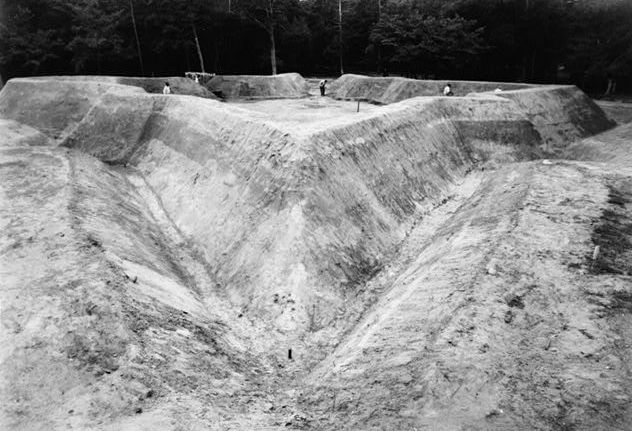
The enigmatic Fort Raleigh is on the shores of Roanoke Island, nestled amidst lush greenery and whispering waters. Often enveloped in the shadow of one of America’s oldest mysteries, this fort tells the tale of the earliest English settlers’ hopes, challenges, and unexplained disappearance.
First Touchpoint: The Elizabethan Adventure (1580s)
Under the reign of Queen Elizabeth I, England started looking westward with colonization ambitions, so Sir Walter Raleigh emerged as a pioneering figure.
Granted a charter by the Queen, Raleigh initiated the daring endeavor of establishing England’s first foothold in the New World. In the 1580s, a group of settlers journeyed across the vast Atlantic, choosing Roanoke Island as their destination.
Fort Raleigh was swiftly established as a protective barrier against potential indigenous hostilities and a symbol of English persistence. With the fort as their base, these settlers embarked on the audacious journey of carving a life in this uncharted territory.
The Mystery Deepens: The Tale of the Lost Colony
The hopeful beginning soon took a perplexing turn. Facing many challenges, including dwindling supplies and the need for reinforcements, the colony’s leader, John White, made the arduous journey back to England.
The Anglo-Spanish War delayed his return to Roanoke, but when he finally returned in 1590, he found Fort Raleigh and the entire colony deserted. The cryptic word “CROATOAN” etched into a wooden post was the only clue to their whereabouts.
The fate of these settlers, including White’s granddaughter, Virginia Dare – the first English child born in the New World – remains shrouded in mystery to this day. While theories abound, definitive answers have eluded historians for centuries.
Preserving the Past: Fort Raleigh Today
Today, Fort Raleigh stands rejuvenated as a National Historic Site. It’s not just a magnet for historians and archaeologists but also a pilgrimage site for the general public, eager to glimpse a chapter from the dawn of English America.
Detailed exhibits, relics from the past, and interpretative programs at the visitor center bring alive the stories and speculations surrounding the settlers.
Walking through the fort’s remains and the surrounding landscapes, one can almost hear the echoes of the settlers’ dreams, their daily lives, and the following puzzling silence.
4. Fort Holmes (1863-1865)
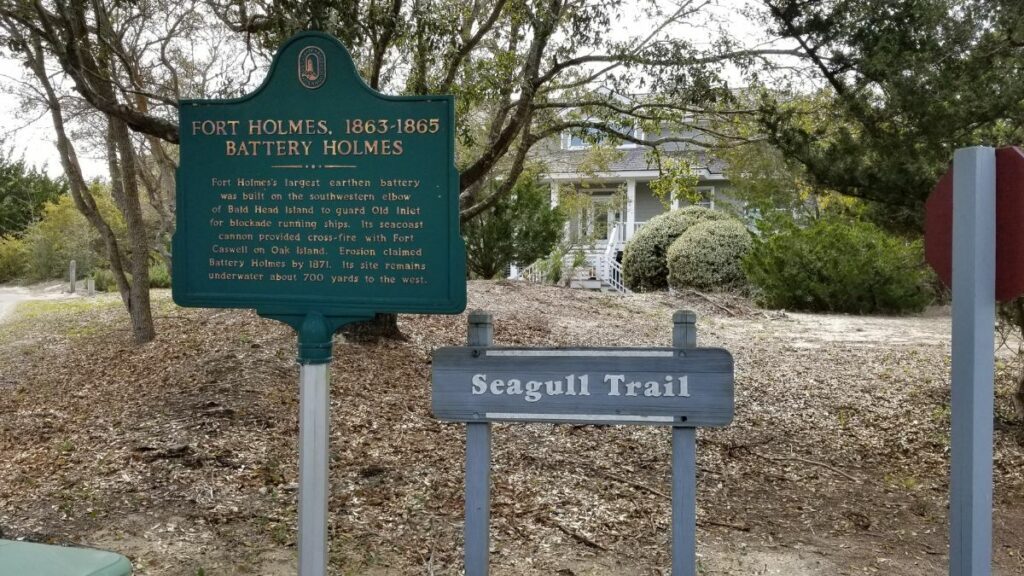
Tucked away on the northern reaches of Roanoke Island, the remnants of Fort Holmes stand as quiet witnesses to a turbulent past.
This Confederate earthwork fort, crafted from the very soil of the region, speaks to the determination and strategy employed during the Indian War and the Civil War. While time has claimed much of its original form, the tales it holds remain integral to the island’s storied history.
Foundations in Conflict: The Indian War Era
During the Indian Wars, tensions between Native tribes and the expanding European settlers were palpable. The necessity for fortified defenses became evident, and with its strategic location, Roanoke Island was deemed crucial.
Fort Holmes was established not only as a defensive measure against potential Native American raids but also as a symbol of territorial assertion and control.
Constructed primarily as an earthwork, Fort Holmes utilized the natural resources available, blending seamlessly with its environment while providing a robust defense against potential adversaries.
Civil War Resurgence: A Confederate Stronghold
As the United States was embroiled in the Civil War, the importance of Roanoke Island and Fort Holmes surged again.
The Confederacy recognized the island’s strategic value, controlling access to the inland sounds of North Carolina. Given its pre-existing structure, Fort Holmes was repurposed and reinforced to aid in the island’s defense against Union forces.
Though Roanoke Island eventually fell to Union forces in 1862 after a significant battle, Fort Holmes played its role in delaying the inevitable, testifying to the determination of the soldiers garrisoned there.
Echoes of the Past: Fort Holmes Today
While the winds of time have eroded much of the fort’s original earthwork structure, the significance of Fort Holmes endures. What remains now is not just a physical imprint but a rich narrative of an island caught in the crosshairs of conflict.
For history enthusiasts and those seeking a tangible connection to the past, Fort Holmes offers a glimpse into warfare strategies, tales of courage, and the ever-evolving dynamics of a region shaped by its confrontations.
5. Fort Campbell (1862-1865)
Standing guard over the meandering Neuse River and shadowing the strategic town of New Bern, Fort Campbell is a silent testament to the strategic chess game of the American Civil War.
Erected by the Confederacy, this fort bore the weighty responsibility of ensuring that vital supply lines remained open and uncompromised. Even as the tides of war ebbed and flowed, Fort Campbell remained steadfast, its legacy etched in the annals of wartime strategy and resilience.
Strategic Foundations: The Birth of Fort Campbell
As the Civil War intensified, maintaining control over crucial waterways and supply routes became paramount. With its direct access to vital towns like New Bern, the Neuse River was a strategic artery that could not be left unprotected. Recognizing this, the Confederacy swiftly moved to establish Fort Campbell.
Built with a combination of earthworks and fortified structures, the fort was meticulously designed to repel any naval or ground assault, thus ensuring the safe passage of supplies, troops, and vital information.
A Bastion Against the Union: Holding the Line
Throughout the conflict, Union forces recognized the importance of seizing control of the Neuse River and, by extension, towns like New Bern. Consequently, Fort Campbell found itself in the crosshairs of multiple Union campaigns.
With its cannons overlooking the river and its troops ever-vigilant, the fort successfully repelled numerous assaults, thwarting Union ambitions in the region.
Each attack and countermeasure showcased not only the tactical importance of Fort Campbell but also the determination and spirit of the soldiers stationed there. Their resilience ensured that the Confederate supply lines via the Neuse River remained intact for much of the war.
Today’s Legacy: Echoes of Fortitude
While the din of cannons and musket fire has long since faded, the legacy of Fort Campbell remains vibrantly alive. The site offers a tangible link to the strategic maneuverings of the Civil War, providing insights into the intricacies of wartime logistics and the indomitable spirit of those who defended the Confederacy’s lifelines.
6. Fort Branch (1862)
Perched strategically along the Roanoke River’s banks, Fort Branch reminds us of the delicate balance of power, strategy, and resilience during the American Civil War.
Built by Confederate forces, this fort was more than just an architectural feat; it was a statement of intent, safeguarding crucial waterways and ensuring the Confederate states could withstand the mounting pressures from Union advances. Though the fort’s walls have seen the passage of time, the history it cradles remains potent and palpable.
Strategic Impetus: The Construction of Fort Branch
The Civil War highlighted the importance of controlling and defending key transport and communication routes. With the Roanoke River being a vital artery for moving troops, supplies, and information, the Confederacy recognized the pressing need to fortify its banks.
Enter Fort Branch, an engineering marvel of its time, designed to deter and withstand potential Union advances.
With its tiered earthworks, fortified artillery placements, and a strategic viewpoint over the river’s expanse, Fort Branch was an imposing obstacle for any force daring to challenge Confederate dominance in the region.
Stalwart Defense: The Fort’s Role in the War
Fort Branch lived up to its reputation throughout the tumultuous years of the Civil War. The fort became synonymous with resistance against Union naval and ground forces attempting to navigate the Roanoke.
Time and again, its cannons roared in defense, pushing back against Union incursions and ensuring the river remained a secure route for the Confederacy.
The fort’s significance wasn’t just in its physical defenses. The morale boost it provided to Confederate troops in the region, knowing they had such a formidable stronghold guarding their backs, was immeasurable.
Fort Branch Today: A Journey Back in Time
While the echoes of cannon fire and battle cries have long since dissipated, Fort Branch’s legacy endures. Today, the fort is a historical site, drawing in those keen to understand the intricacies of Civil War strategies and the tales of the men who stood guard over the Roanoke.
Walking through the remnants of the fort, one can almost feel the weight of history, from tense moments awaiting potential attacks to the camaraderie among the troops stationed there.
7. Fort Anderson (1861)
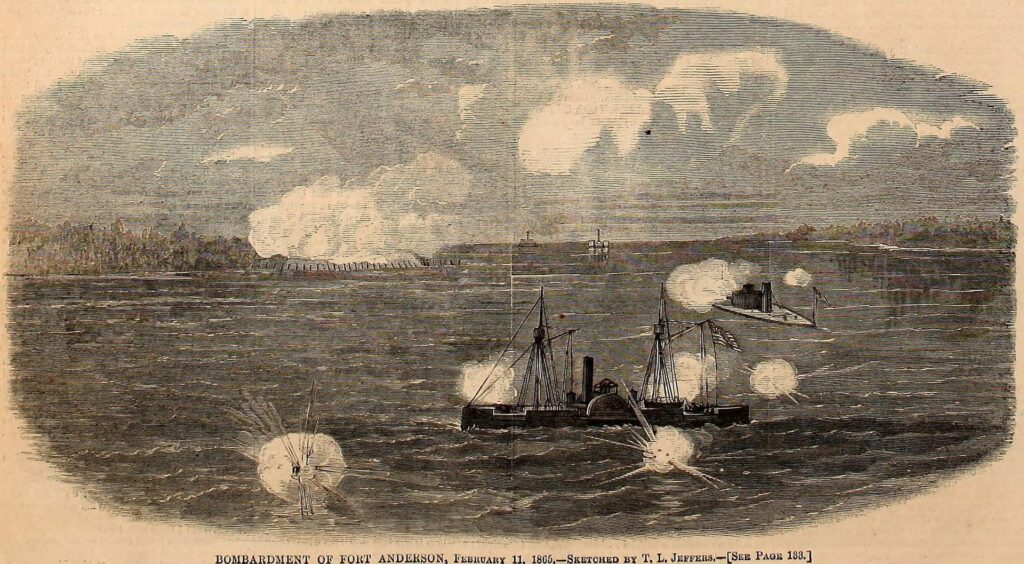
Located in Brunswick County’s heart, Fort Anderson is a stoic monument to a time of division, resilience, and strategy. As a Confederate stronghold during the tumultuous years of the Civil War, its walls and battlements have borne witness to pivotal maritime confrontations, echoing the challenges and triumphs of the South.
Overlooking the Cape Fear River and protecting the strategic port city of Wilmington, Fort Anderson was not just a defense structure but a lifeline, ensuring that vital supply lines remained intact in the face of Union encroachments.
Guarding the Lifeline: Fort Anderson’s Role
The Cape Fear River was more than just a waterway; it was the lifeblood of the Confederacy in North Carolina. With Wilmington being a significant port city and a supply hub, the Confederate forces needed to fortify its access points. Fort Anderson was born out of this necessity, positioned to deter and repel any Union advances.
With artillery batteries aimed out over the river and a garrison of determined soldiers, Fort Anderson posed a formidable challenge to Union ships hoping to breach the Cape Fear and disrupt the Confederate supply chain.
Time and again, its guns would sound out in defense of the South’s interests, ensuring that Wilmington remained an operational and strategic asset for the duration of the conflict.
From Battlements to Historical Beacon: Fort Anderson Today
The cannons may have fallen silent, and the battlements might show the wear of time, but the legacy of Fort Anderson is very much alive. Now a beacon for history enthusiasts, students, and families alike, the fort is a living museum.
Visitors can traverse its grounds, immerse themselves in its storied past, and gain insights into the naval strategies employed during the Civil War.
Interactive exhibits, preserved relics, and guided tours offer a comprehensive journey back in time, allowing guests to experience the era’s ambiance and understand the fort’s pivotal role in the larger tapestry of the war.
8. Fort Macon (1826)
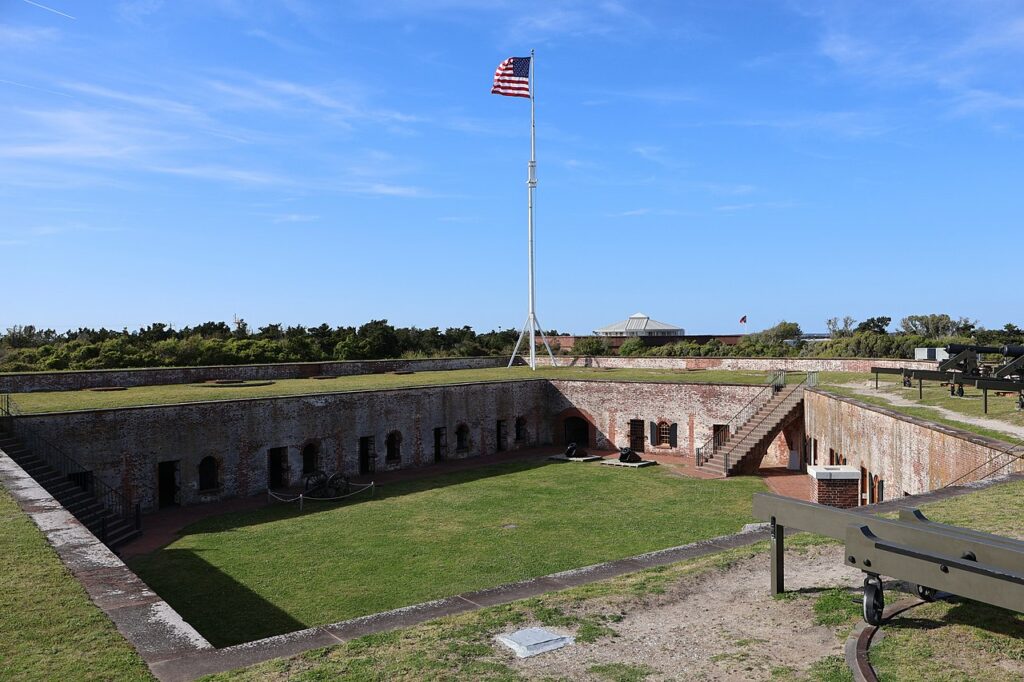
Emerging from the sandy shores of Bogue Banks and overlooking the strategic Beaufort Inlet, Fort Macon is a testament to the ever-evolving tapestry of American military history.
From its earliest days in the 19th century to its roles in two of the most significant wars of modern times, this fort has been a steadfast protector, a symbol of resilience, and a living museum of the past.
Located within the beautiful confines of Fort Macon State Park, near Atlantic Beach and Morehead City, this historic fort beckons visitors with its tales of courage, strategy, and heritage.
An Early Protector: Fort Macon’s Inception
Fort Macon’s importance was recognized soon after the War of 1812, leading to its completion in 1826. Its primary purpose was to shield the Beaufort Inlet, a crucial maritime route, ensuring safe passage for ships and safeguarding the nearby settlements from potential adversaries.
Built with thick walls and advanced (for its time) defensive features, Fort Macon showcased its builders’ architectural and strategic prowess.
Between Blue and Grey: The Civil War Years
The Civil War saw Fort Macon’s fortifications tested like never before. A key stronghold for Confederate forces, its guns, and battlements became synonymous with the defense of the Southern coastline.
The fort’s involvement in the war culminated in a significant siege in 1862, showcasing its strengths and vulnerabilities. While it eventually fell to Union forces, its resilience and the determination of its garrison left an indelible mark on the war’s history.
From Civil Strife to World Conflict: World War II and Beyond
While many might associate Fort Macon primarily with the Civil War, its service extended into the 20th century, revitalized for use during World War II, and became part of a broader network of coastal defenses. As modern warfare evolved, so did the fort, adapting to the new challenges and threats of a changing global landscape.
Exploring Today’s Fort Macon
Today, Fort Macon is not a bastion of defense but a portal to the past. Visitors can delve into the fort’s intricate history within Fort Macon State Park through guided tours, interactive exhibits, and well-preserved structures.
The gift shop offers souvenirs of the experience, while educational programs and events ensure that younger generations understand and appreciate the fort’s significance.
9. Fort Johnston (1748-1881)

On the shores of Southport, overlooking the vast expanse of the Cape Fear River, Fort Johnston stands as a sentinel to history, watching over centuries of maritime and military transformations.
From its origins in the tumult of the American Revolution to the intense conflicts of the Civil War, Fort Johnston has been a critical vantage point, shielding the region and bearing witness to the ebbs and flows of American conflict. Today, its legacy is a tapestry woven with tales of strategy, bravery, and resilience.
A Revolutionary Beginning: The Inception of Fort Johnston
Named in honor of North Carolina’s royal governor, Gabriel Johnston, Fort Johnston’s birth was intrinsically tied to the early days of the American struggle for independence.
Established to protect the strategic Cape Fear River—a lifeline for trade and communication—the fort soon became a pivotal defense point against potential adversaries, whether European powers or domestic threats.
Civil War Echoes: A Confederate Stronghold
Fort Johnston’s role took on renewed significance as the American Civil War tides swelled. Garrisoned by Confederate troops, the fort was instrumental in protecting the Cape Fear region, serving as a deterrent and a defense against Union advances.
As Wilmington became a crucial port and supply hub for the Confederacy, Fort Johnston’s guns and battlements were critical in ensuring that the city remained in Southern hands for most of the war.
A Legacy Preserved: Fort Johnston Today
While the sounds of cannon fire and battle cries have long faded, Fort Johnston’s historical significance remains undiminished. Drawing in scholars, history enthusiasts, and families, the fort provides a window into bygone eras, offering insights into military strategy, local history, and the broader narratives of American conflict.
The fort’s structures and surroundings have been painstakingly preserved, allowing visitors to step back in time and immerse themselves in the ambiance of historic epochs. From guided tours to interpretative panels, Fort Johnston’s story is told with reverence and detail, ensuring its legacy lives on.
10. Fort Dobbs (1756)

Sitting within the heart of North Carolina’s Piedmont region, Fort Dobbs symbolizes the colony’s tumultuous frontier era. However, it functioned relatively briefly in the 18th century; its role in the French and Indian War and as a defensive bastion for early settlers against Native American hostilities is profound.
Today, as visitors tread upon its grounds, they are transported back to when the destiny of North Carolina’s western frontier hung in the balance, and Fort Dobbs was at its epicenter.
A Precarious Frontier: The Setting of Fort Dobbs
Established in 1756, Fort Dobbs was constructed amidst the more prominent global conflict between the British and French empires, known in North America as the French and Indian War.
Situated strategically near present-day Statesville, the fort aimed to protect the colony’s western settlements from potential threats, particularly from Native American tribes allied with the French.
Design and Fortifications: A Unique Structure
Uniquely designed, Fort Dobbs was not a typical fortification of its time.
Constructed mainly from wood and featuring a three-story blockhouse, it was equipped to house a garrison of soldiers and provide a safe refuge for settlers in times of crisis. Its architecture reflects the adaptability and resourcefulness of colonial frontier defenses.
Conflict and Defense: The Role of Fort Dobbs
Throughout its operational years, Fort Dobbs was a hive of military activity. One of its most notable moments was in 1760 when the fort successfully repelled an attack by Cherokee warriors.
This engagement underscored the fort’s significance as a protective shield for North Carolina’s burgeoning western settlements.
Rediscovery and Preservation: Bringing History to Life
While the original Fort Dobbs no longer stands, intensive archaeological efforts and research have unearthed its foundations and many artifacts, painting a vivid picture of life on the frontier.
Thanks to these efforts, a reconstruction of the fort allows visitors to experience a tangible connection to the 18th-century colonial era. The site serves as an educational hub, offering reenactments, tours, and interactive programs that dive deep into the period’s history and challenges.
Related: Army Forts in North Carolina
Conclusion: Historic Forts in North Carolina
The forts that dot North Carolina’s varied landscapes, from its sunlit coastlines to its rolling piedmont, serve as enduring testaments to the state’s rich and varied military history. Each brick laid, each cannon mounted, and every battle fought within their walls or under their shadows echoes the challenges and triumphs of the past.
These forts are silent witnesses to the changing tides—war, politics, and society. They remind us of the sacrifices made by countless individuals in the pursuit of freedom, security, and nation-building.
As we walk the grounds of these historic sites, from Fort Macon’s coastal ramparts to Fort Dobbs’ frontier blockhouse, we are not just stepping on historic land but also entering a living tapestry of stories, memories, and lessons.
North Carolina’s historic forts are relics of bygone eras and vibrant chapters in the ongoing narrative of a state and nation’s resilience, innovation, and spirit. As we look towards the future, may we continue to honor, preserve, and learn from these bastions of our shared heritage.
If you have visited any of these fascinating forts, we would love to hear about your experience in the comments section below.

Cory is a website owner and content creator who enjoys fishing, history, coin collecting, and sports, among other hobbies. He is a husband and father of four.
Romans 15:4 For whatever was written in former days was written for our instruction, that through endurance and through the encouragement of the Scriptures we might have hope.

